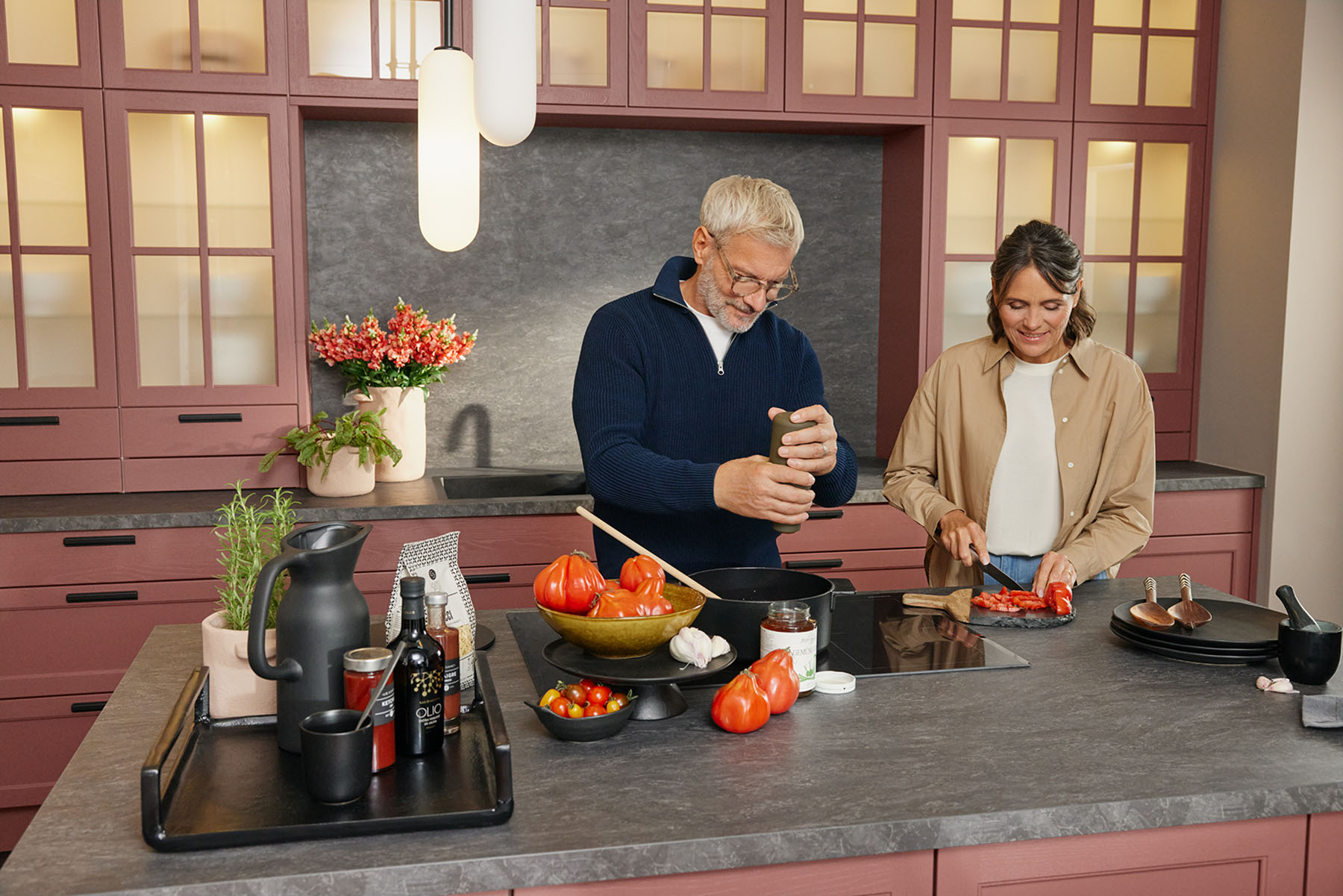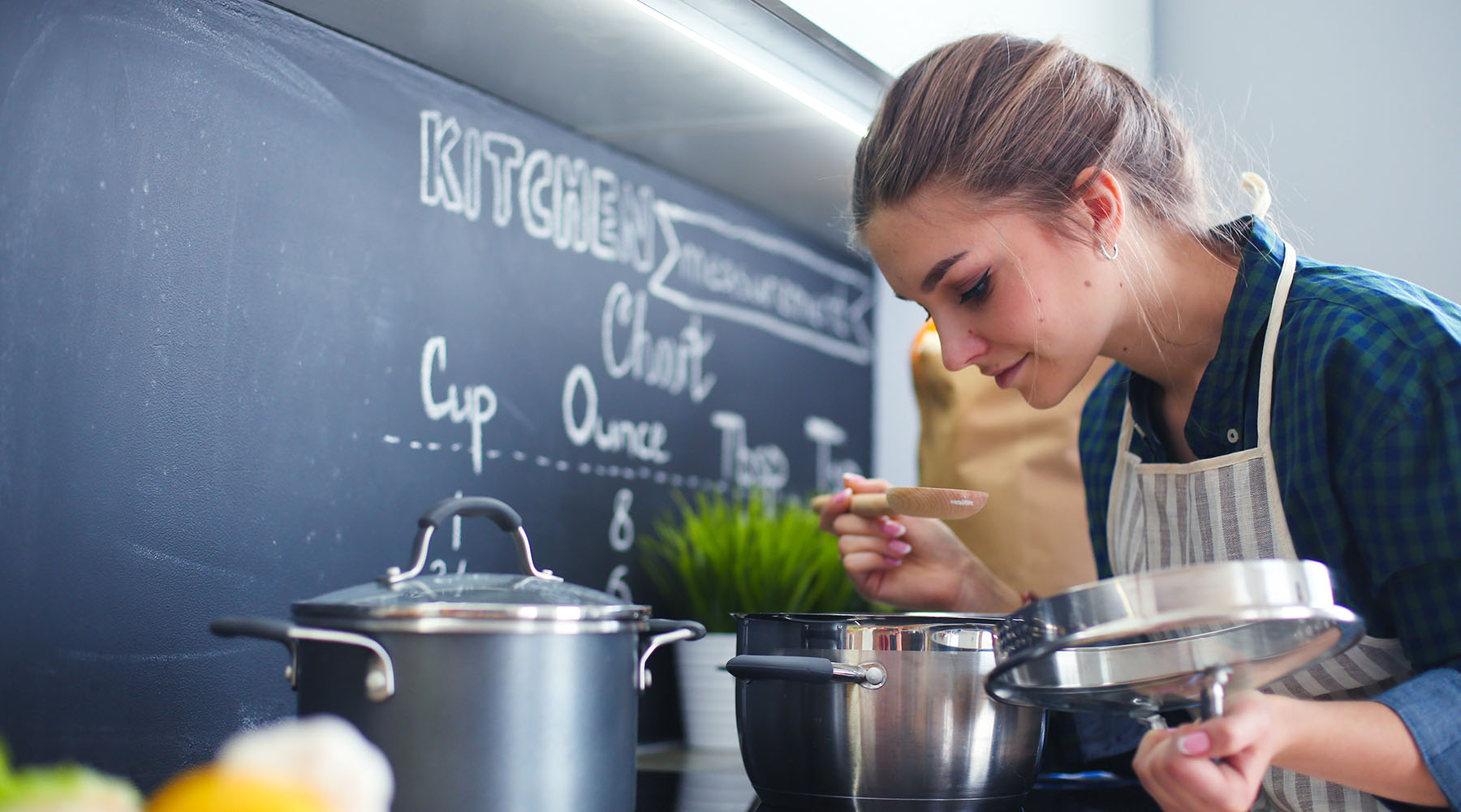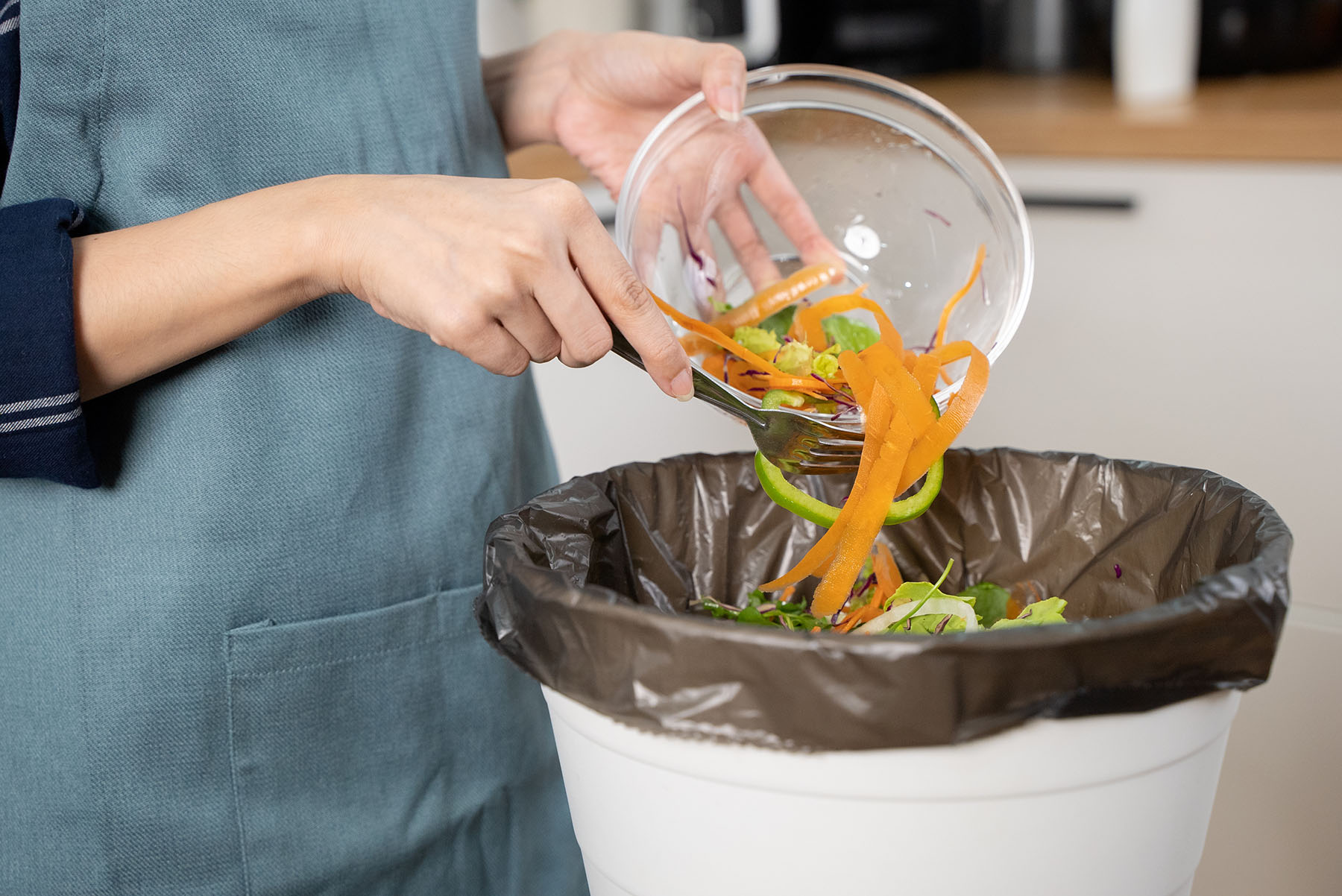Sustainable shopping and food storage
Sustainable cooking doesn't just start with choosing the right food, but much sooner – it starts on the way to the supermarket. Whether emissions are caused by getting to the supermarket is also key factor determining our food's carbon footprint. So, why not leave your car where it is and cycle or walk short distances instead. Not only will this protect our environment, it's healthy too! If your food shop happens to be too big to get it home by bike or on foot, public transport can be a very good choice too. If you can't avoid using the car, it's a good idea to plan your shopping carefully in advance so as to avoid unnecessary trips.

The good, old shopping list …
Good planning is half the battle. This also goes for sustainable shopping. These 4 tips will help you to write your shopping list:
1. Make an exact plan of what you want to cook and eat over the next few days.
2. Check your fridge and pantry to get a picture of what you still have. What do you still need to get?
3. Write a shopping list, including quantities – either digitally or by hand – that you can then tick off when you go shopping.
4.Tip: you may be able to do without certain ingredients, such as those you can't use up completely. You may be able to swap them for other ingredients that can be used more easily?
Seasonal, regional and organic
Anyone wishing to shop on a climate-friendly basis is well-advised to follow this rule of thumb: regional, seasonal, little meat and, wherever possible, of organic origin. Organic labels make it easier for you to identify ecologically correct products. Particularly with animal-based products as well as with fruit and vegetables, it is advisable to opt for organic quality.
Reducing plastic & disposable packaging
When choosing the right food in the supermarket, it's also important to go for products that come in the right packaging or, even better, unpacked. Although Germany is considered to be the world's recycling pioneer, only part of the plastic waste produced is recycled in this country too. The remainder is incinerated or ends up in huge landfills, from where it ultimately finishes up in the natural world, for example in the sea – or finds its way back into our food cycle. Reducing plastic starts with shopping. This is where these tips can help:- Always have a jute or cloth bag with you.
- It is best to buy goods loose and unpacked.
- Avoid bagged-up fruit and vegetables.
- Avoid foods pointlessly wrapped in plastic (like shrink-wrapped cucumbers).
- Please don't use black plastic packaging, as this can't be recycled at all.
- Ready meals are almost always packed in several layers of different materials – please avoid them.
- Go for glass bottles and reusable bottles over disposable ones.
- Jars rather than tin cans.
- Look out for a local zero-waste shop.
The right way to keep food and avoid waste
After buying food items on a sustainable basis, these will, ideally, be stored in a suitable place in the kitchen, kitchen cupboard or pantry. To keep food at its best for as long as possible, it's a good idea to sort through items stored in a pantry/cupboard, freeze or preserve them and always check the best-before date.
Proper storage
Some everyday ingredients are great for keeping in reserve, such as cereal products, tinned foods, pulses and nuts. Stored in a dry and dark place, these foods will last much longer. Some ingredients are better refrigerated, others kept in airtight jars. Many fresh foods can also be wonderfully preserved! The maxim being: get yourself genned up on how to store food properly. This way, your food will last 'forever' so to speak and doesn't have to be thrown away before time and end up wasted.
Check the best-before date
The best-before date (MHD) is a term that can be taken literally. It's not an expiry date. This means: up to this date, the manufacturer guarantees that an unopened product will not change its specific properties if stored correctly until such time. Yet this doesn't automatically mean it's inedible once the date has passed. Unopened and correctly stored, some foods can be eaten even months after the best-before date and may only change colour and taste slightly less intense.
Freezing rather than throwing away
Overbought and can't manage to use all of those fresh ingredients in time? No problem – just freeze them!
- Sliced, fresh bread is great for freezing and toasting.
- Simply peel and slice ripe bananas and put them in the freezer – the perfect basis for banana bread and nicecream (vegan ice cream).
- Berries are great for freezing and easily defrost and purée later on with other fruits to make smoothies.
- Cubed vegetables freeze without a problem.
- Freeze soups, chilli and stews in portions – they often taste even more aromatic after defrosting.
If you want to store your food sustainably, we wouldn't advise using cling film and aluminium foil to pack your food. Reusable lunch boxes, beeswax wraps or jars are ideal for storing food in.
Sustainability has always been a matter close to our hearts. If you want to learn more about sustainable kitchens and cooking, click here to read more.

Sustainable cooking: simple, everyday tips
Cooking with less water
Water is food and energy medium alike. It is used in cooking as the basis for various dishes as well as a heat-conducting element for making raw foods edible. Using water sparingly reduces cooking time and saves energy. A pressure cooker is particularly recommended for cooking. Not only saving 30 per cent of the electricity used, a pressure cooker can reduce cooking time as much as 50 per cent.
Using leftover food
Even if you organise your shopping well, food is sometimes left over. This often makes the perfect basis for cooking leftovers with friends or spicing up other recipes. And if all else fails, simply freeze food leftovers or preserve them.
3 easy and healthy recipes
Our recipe collection has something for everyone. Even many oriental dishes are often very easy to cook at home.
Rote lentil curry
Anyone liking Indian and healthy food that's not too hot will love our red lentil curry. Pulses are very healthy, keep you feeling full over many hours and give this curry its unique flavour. Simply cook it for yourself!Pizza Margherita
Usually, you can't go far wrong with a pizza margherita. It's popular at any get-together, goes down well with children and, to be honest, perfect for any occasion. And best of all, it's relatively easy to do. See for yourself!Börek
For this delicious börek, you really do only need 4 ingredients. Accompanied by a crisp, mixed salad, some yoghurt and voilà: it's ready, the homemade oriental classic. Click here for the recipe.
Tips on saving electricity when cooking
- Use a kettle to boil water. In quantities below 1.7 litres, this is usually more energy-efficient than a saucepan. For larger quantities: boil as much water as will fill a kettle and heat the remaining amount in a saucepan alongside.
- Always use a lid to fit the saucepan when boiling water.
- Cook or bake several dishes in the oven at one and the same time. Cue: mealprep.
- Utilise the residual heat when cooking and baking: don't be afraid to turn off the oven a few minutes before the end of baking. The temperature will remain high enough to get the dish finished.
Choosing and using the right kitchen utensils
Modern kitchen appliances play a key part in using energy efficiently. They must always be in proper working order. Energy labels for kitchen appliances can also be a good guide to purchasing energy-efficient kitchen appliances.
When cooking, always choose a saucepan or frying pan of the ideal size for the hotplate and use a lid that provides a perfect fit.


Sustainable waste disposal
Even if you do manage to reduce the amount of waste in your kitchen – it's usually impossible to avoid it completely. But this makes it all the more worthwhile to optimise the use of your local waste and recycling system by correctly disposing of all materials used.Avoiding food waste
Even the most sustainably produced organic apple from the next village becomes an environmental and climate problem if it goes bad before you use it. On average, 75 kilos of food are thrown away per head and year in Germany alone. This wastes energy, water and the soil used to produce it. What can you do to prevent this? Basically, by carefully planning your meals and related purchases in advance and also by putting anything left over to good use or storing it in the proper way.
Sorting waste and recycling
This is a simple way of helping to recycle more plastic and paper in everyday life instead of incinerating it as non-recyclable waste.
- Always dispose of all-plastic and paper packaging separately from non-recyclable waste in line with your specific region's waste-sorting regulations. This is the most likely way of ensuring that all sorted packaging will also be recycled.
- Always completely remove the aluminium top from a yoghurt pot!
- Some products have detachable paper sleeves. Actively peel these off when throwing them away and dispose of them separately as paper waste.
- Classic white till receipts must be disposed of as non-recyclable waste because of the many chemicals that go into producing them. Blue receipts, on the other hand, can be disposed of as waste paper.
Sorting waste and composting organic leftovers
Anyone want to cook and live sustainably can't avoid the subject of sorting waste. Whether plastic, paper, organic or non-recyclable waste: each material has its own specific bin. Use it for the sake of the environment.
What can be composted?
The rule of thumb: everything can be composted before it lands in the pot or pan. Food, sauces and gravies that have been cooked or fried must be disposed of as non-recyclable waste as they attract rats and other vermin on the compost heap.
Recycling kitchen appliances
Don't simply discard faulty kitchen appliances as rubbish because they provide a source of recovering large quantities of valuable and scarce metals. It is also important to ensure the safe disposal of pollutants that could otherwise quickly end up in our air, our soil and, ultimately, in our body. If the manufacturer does not take back your appliance for disposal, the right way to go is dispose of them in the proper way at an electric and electronic waste collection point. There, valuable materials can still be recovered from EOL appliances and the environment doesn't suffer any unnecessary pollution.
Sustainable cooking - longer life
Did you know studies show people who regularly cook for themselves live longer?
Anyone looking at food more closely and making their own meals usually eat a healthier diet too. This means sustainable cooking is not only good for our environment, but definitely for our health as well.
Our advice: plan your meals in advance and cook several portions at once. This saves you time and still regularly gives you something healthy to eat.
Click here to read more about sustainability and find out how you can make both your kitchen and cooking sustainable.

